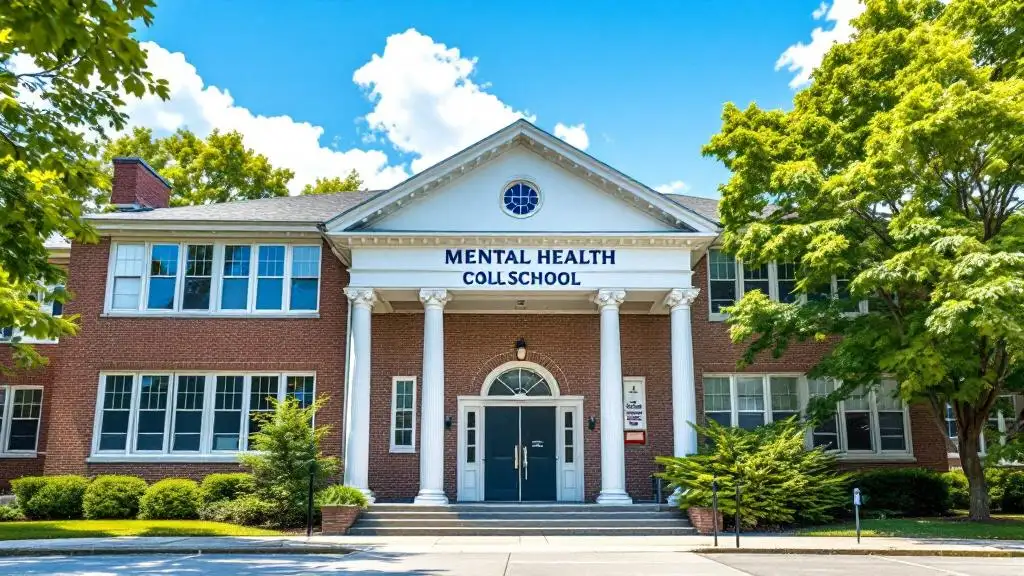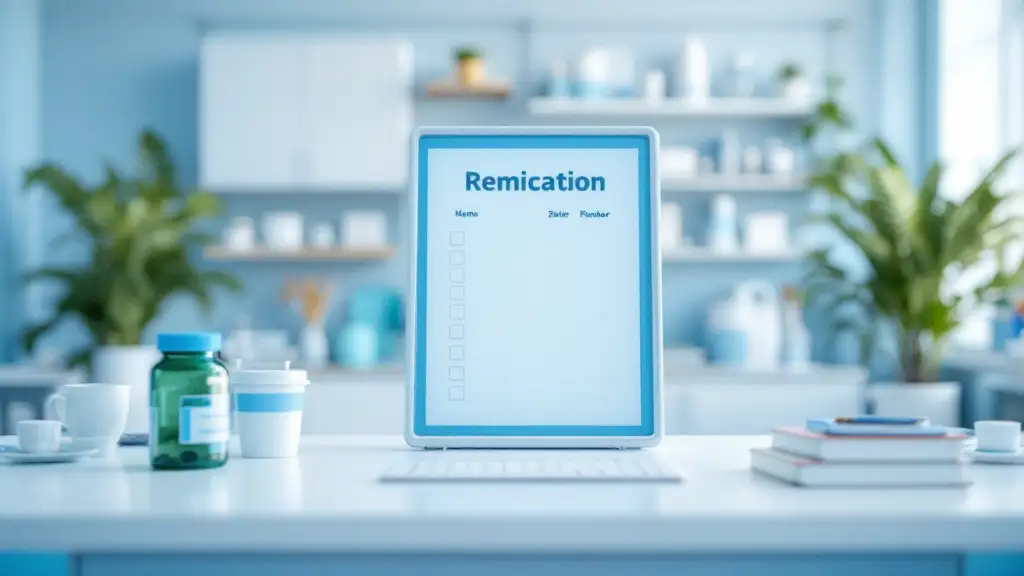Understanding the Foundations of Group Therapy for Mood Conditions
Group therapy is a cornerstone intervention for adult mood disorders, combining principles of shared support, confidentiality, and diverse therapeutic approaches. Its development dates back over a century, with historical roots showing its efficacy in fostering hope and recovery. This article explores how structured activities, facilitator roles, and tailored adaptations contribute to effective treatment outcomes.
Principles and Practices of Group Therapy for Adult Mood Disorders
What are the principles and practices of group therapy for adult mood disorders?
Group therapy for adults suffering from mood disorders such as depression and bipolar disorder relies on core principles designed to foster a supportive and effective treatment environment. Central to these principles is maintaining strict confidentiality, which ensures members feel safe sharing personal experiences without fear of judgment or disclosure outside the group.
Mutual support is another fundamental aspect, with participants encouraged to share their stories, struggles, and successes. This shared experience creates a sense of universality—helping members realize they are not alone in their struggles—and instills hope for recovery.
Creating a safe environment is essential for facilitating open self-expression. Facilitators—usually trained mental health professionals like psychologists or social workers—structure activities and discussions that promote empathy, understanding, and emotional growth.
Group therapy employs a range of theoretical orientations tailored to treat mood disorders effectively: including cognitive-behavioral therapy (CBT), psychodynamic approaches, interpersonal therapy, and systems-based models.
Cognitive-behavioral group therapy often features activities such as thought replacement exercises, behavioral activation, and coping strategies aimed at reducing depressive symptoms and improving mood.
Psychodynamic approaches explore underlying emotional conflicts and patterns, often through expressive arts and storytelling, to foster insight and personal growth.
Interpersonal therapy focuses on improving relationship skills and addressing social issues impacting mood health, using role-playing and sharing life stories to enhance understanding and support.
Systems-based approaches consider the individual's family and social context, using family mapping and communication exercises to strengthen relational dynamics.
How does the group development process support effective treatment?
Group development follows several stages, each vital for building trust and cohesion among members. The initial forming stage is about establishing trust, clarifying expectations, and setting group norms.
As the group transitions into storming, conflicts or disagreements may arise, providing opportunities to develop communication skills and resilience.
During norming, members begin to establish routines, develop familiarity, and support each other's progress.
The performing stage is characterized by active engagement, shared goals, and mutual support, which maximize therapeutic benefits.
Finally, adjourning involves consolidating progress, reflecting on growth, and preparing members for independence post-therapy. Properly managing these stages ensures a cohesive group climate conducive to healing.
Why are cohesion, universality, hope, and safety central to group therapy?
Group cohesion—the sense of belonging and connection among members—is strongly linked with positive therapy outcomes. When individuals feel accepted and understood, they are more likely to participate fully and honestly.
Universality—that members find common ground in their experiences—reduces feelings of isolation and fosters shared understanding.
The conversion of hope into practice is vital; witnessing peers' progress instills optimism and motivates continued effort in one's own recovery.
Safety within the group is foundational. Facilitators must create an environment free from judgment, where vulnerability is welcomed and protected. This safety encourages openness, emotional expression, and genuine engagement.
Integrating Practice: Techniques and Strategies
Group therapy sessions incorporate diverse activities such as mindfulness exercises, role-playing, art therapy, and structured discussions, all designed to promote self-awareness, emotional regulation, and interpersonal skills.
Facilitators continuously monitor group dynamics, adjust activities to maximize participation, and manage conflicts to maintain a therapeutic atmosphere.
The combination of these principles, developmental stages, and supportive strategies makes group therapy a powerful, evidence-based approach for treating mood disorders, offering a platform for recovery, resilience, and personal growth.
Supporting Emotional Growth and Recovery through Techniques and Activities
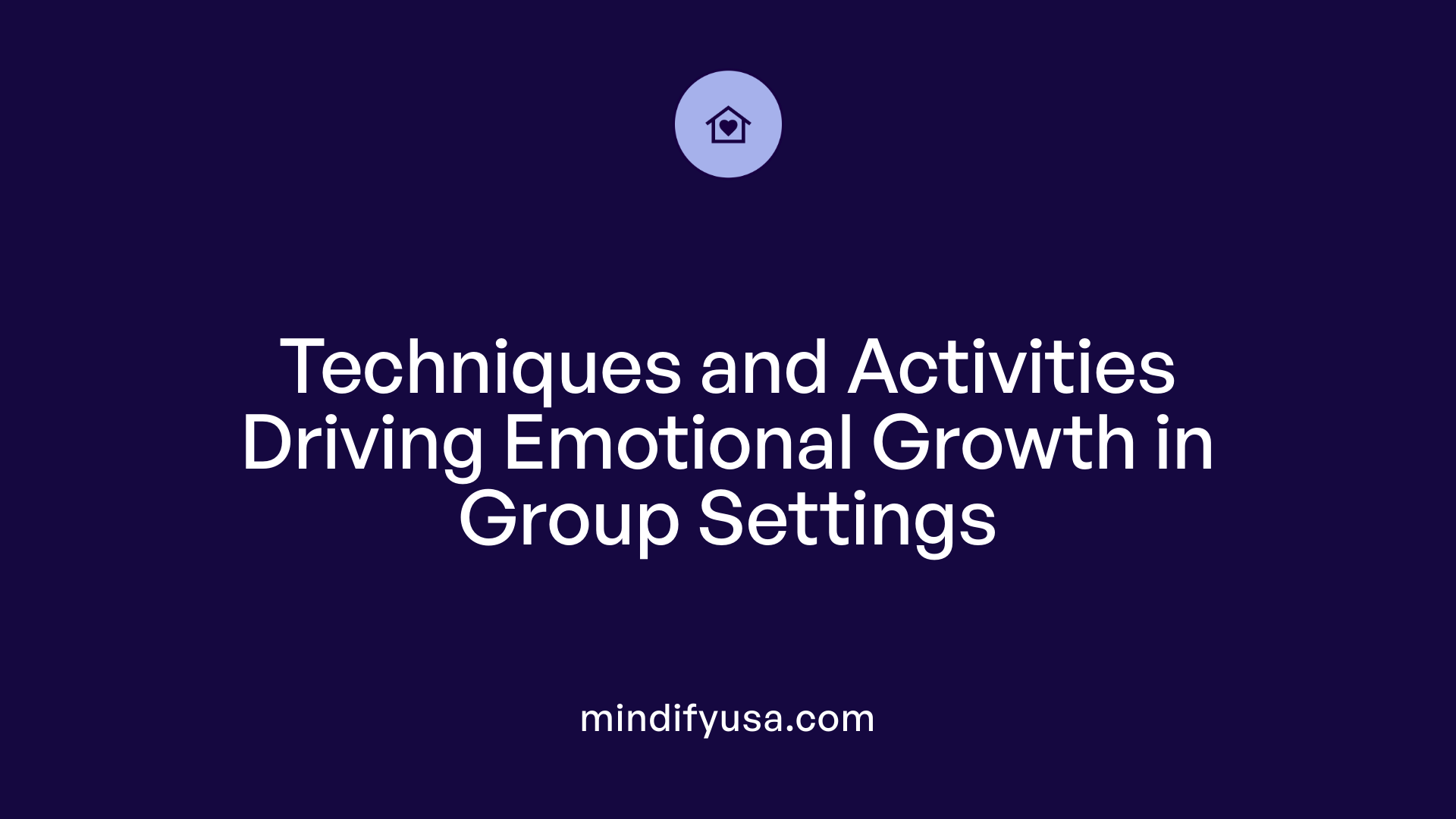
How do group therapy techniques support emotional growth and recovery in adults with mood conditions?
Group therapy offers a powerful platform for adults dealing with mood disorders such as depression, anxiety, and bipolar disorder. By fostering a safe and supportive setting, it encourages individuals to share their experiences and feelings without fear of judgment.
Various activities and techniques are employed to promote healing and personal development. Role-playing allows participants to practice real-life situations and respond with healthier behaviors. Creative outlets like art therapy and storytelling help individuals express emotions that may be difficult to articulate with words alone.
Mindfulness exercises, including mindful breathing, eating, and yoga, assist in managing stress and enhancing emotional regulation. Psychoeducational components provide crucial information about mental health conditions, empowering clients to better understand and manage their symptoms.
Evidence-based methods like Cognitive Behavioral Therapy (CBT) and Dialectical Behavior Therapy (DBT) are integrated into sessions to teach practical skills such as cognitive restructuring, emotion regulation, and distress tolerance.
These activities also foster a sense of shared understanding among group members, intentionally reducing feelings of isolation and stigma often associated with mood conditions.
Activities tailored to specific emotional challenges
- For Anxiety and Depression: Affirmations, goal-setting brainstorms, and thought-replacement exercises based on CBT.
- For Grief and Loss: Discussing triggers, sharing positive memories, and expressing feelings around loss.
- To Combat Loneliness: Pair interviews and person-to-person interactions designed to build social connections.
- Supporting Personal Growth: Strength recognition, creating worth jars, and affirmations that bolster self-esteem.
Use of evidence-based methods like CBT and Dialectical Behavior Therapy (DBT)
Implementing strategies from CBT and DBT enhances emotional skills in participants. For example, thought-replacement exercises help reframe negative thinking patterns. DBT techniques target emotional dysregulation, promoting more stable moods and reducing impulsivity.
These therapies are adapted into group settings, amplifying their effectiveness through social learning. Participants observe peers, practice new skills, and receive feedback, which accelerates their recovery journey.
Shared understanding reducing isolation
One of the core benefits of group therapy is the sense of community it builds. Knowing others face similar struggles minimizes feelings of loneliness and shame. Shared stories and collective activities create bonds, making individuals feel understood and supported.
This communal aspect not only alleviates emotional distress but also strengthens resilience, as members learn from each other's coping strategies and successes.
Activities specific to anxiety, depression, grief, loneliness, and personal growth
| Condition/Difficulty | Typical Activities | Purpose | Additional Details |
|---|---|---|---|
| Anxiety & Depression | Affirmations, goal brainstorming, thought replacement | Manage symptoms, develop coping skills | Based on CBT principles, aim to shift thought patterns |
| Grief & Loss | Sharing memories, discussing triggers | Process emotions, foster healing | Facilitates emotional expression and memory integration |
| Loneliness | Pair interviews, social connection activities | Build relationships, reduce isolation | Promotes real-time interactions to foster bonds |
| Personal Growth | Strength exercises, worth jars, affirmations | Enhance self-esteem, self-awareness | Encourage positive self-view and resilience |
| Overall Mental Wellbeing | Mindfulness exercises, psychoeducation | Improve emotional regulation and understanding | Broader strategies applicable across conditions |
Additional insights into group dynamics and therapeutic effectiveness
Group therapy involves various stages, from initial forming to final adjourning, each contributing to trust-building and cohesion. Skilled facilitators guide discussions, monitor emotional safety, and foster constructive interactions.
Different therapy models—interpersonal, psychodynamic, social systems, and cognitive-behavioral—offer diverse pathways for healing. Evidence shows that group therapy can be as effective as individual sessions, often at a lower cost and with broader access.
Furthermore, during circumstances like the COVID-19 pandemic, virtual group sessions via secure platforms proved successful, maintaining continuity of care and peer support.
In summary, group therapy techniques harness social interaction, experiential activities, and evidence-based interventions to nurture emotional growth, facilitate recovery, and build resilience among adults facing mood disorders and related challenges.
Therapist Roles and Group Dynamics in Treatment Effectiveness

What roles do therapists and group dynamics play in facilitating effective treatment for adult mood disorders?
Therapists are central to the success of group therapy, especially when treating adult mood disorders such as depression and anxiety. They serve multiple roles, including setting a safe and welcoming environment, guiding discussions, and monitoring group interactions.
A therapist’s primary responsibility is to establish trust and safety within the group. This involves creating a space where members feel comfortable sharing their thoughts and emotions without fear of judgment. By doing so, therapists foster a sense of cohesion and openness, which are crucial for effective therapy.
Guiding discussions is another vital role. Therapists facilitate conversations that help members explore their feelings, challenge maladaptive thoughts, and develop healthier perspectives. Depending on the therapeutic approach—be it cognitive-behavioral, psychodynamic, or interpersonal—the therapist tailors their guidance to support symptom reduction and emotional growth.
Monitoring group dynamics allows therapists to observe how members interact, identify emerging conflicts, and intervene when necessary. This vigilance helps prevent microaggressions, manage resistance, and handle cultural sensitivities, ensuring that the environment remains supportive and respectful.
Creating a trusting environment involves establishing clear boundaries, confidentiality, and mutual respect. It encourages vulnerability, which is often necessary for meaningful change. When conflicts or misunderstandings arise, skilled therapists address them constructively, fostering reconciliation and deeper understanding.
Creating a trusting environment and managing conflicts
Trust serves as the foundation of effective group therapy. Therapists use empathetic listening, validation, and transparency to build rapport with members. They also facilitate activities that promote sharing and mutual support, reinforcing feelings of belonging.
Conflict management is another essential component. Groups inevitably encounter disagreements or tension. Therapists guide members through conflicts by promoting open communication and emphasizing the shared goal of healing. They intervene when conflicts threaten group cohesion and work to turn challenges into opportunities for growth.
Handling conflicts, microaggressions, cultural sensitivities
Microaggressions and cultural differences can impact group harmony. Therapists are trained to recognize subtle forms of bias or misunderstanding and address them promptly and sensitively. This might involve clarifying intentions, educating members on cultural awareness, and promoting inclusive language.
Handling conflicts involves validating each member’s perspective while maintaining the group’s safety. Techniques such as role-playing, guided conversations, or clarification requests help resolve concerns constructively.
Group factors like universality, hope, cohesion, social skills
Several factors make group therapy particularly effective for adult mood disorders. Universality helps members realize they are not alone in their struggles, reducing feelings of isolation.
Hope is reinforced through shared experiences and observing others' progress, which inspires motivation and optimism.
Cohesion, or the sense of belonging within the group, fosters trust and encourages active participation.
Social skills development occurs as members practice communication, empathy, and assertiveness in a safe environment. These skills translate into real-world relationships, supporting overall emotional well-being.
Group development stages and their impact on treatment
Group therapy typically progresses through stages: forming, storming, norming, performing, and adjourning.
During the forming stage, members get acquainted and set group norms. As they move into storming, conflicts may surface, which, if managed well, lead to deeper trust.
In the norming stage, cohesion strengthens as members establish shared goals and boundaries. During performing, the group is most productive, working actively on personal growth and symptom management.
Finally, the adjourning phase prepares members for termination, encouraging reflection and consolidation of gains.
Understanding these stages helps therapists tailor their interventions, ensuring that group members experience growth throughout the process.
How do these factors influence the success of group therapy in treating mood disorders?
The synergy of skilled therapist facilitation and positive group dynamics creates a therapeutic environment conducive to healing. When trust is established and conflicts are managed effectively, members are more likely to engage in meaningful sharing and apply learned skills.
Group cohesion and universality provide emotional safety, reducing stigma and fostering openness.
Overall, these elements support not just symptom alleviation but also the development of social and emotional competencies, which are vital for long-term recovery.
| Aspect | Description | Impact on Treatment |
|---|---|---|
| Facilitator Roles | Establish safety, guide discussions, monitor dynamics | Enhance engagement, handle conflicts, promote trust |
| Trust and Safety | Create secure, respectful environment | Encourage openness, vulnerability, and authenticity |
| Managing Conflicts | Address microaggressions, cultural sensitivities | Maintain respect, promote understanding, prevent dropout |
| Therapeutic Factors | Universality, hope, cohesion, social skills | Reduce isolation, foster optimism and resilience |
| Development Stages | Forming, storming, norming, performing, adjourning | Support progressive growth and consolidation of gains |
In summary, effective treatment outcomes depend heavily on the therapist’s ability to facilitate a safe, respectful, and supportive environment. By recognizing and nurturing group dynamics, therapists can significantly enhance the healing process for adults grappling with mood disorders.
Evidence for the Efficacy of Group Therapy
How does group therapy improve symptoms, quality of life, and overall wellbeing?
Research consistently supports that group therapy can lead to meaningful improvements in individuals suffering from mood and mental health disorders. Participants often report reductions in depressive and anxiety symptoms, enhanced self-esteem, and better emotional regulation. The social interaction and shared experience fostered in group settings help individuals develop resilience, gain new coping skills, and feel less isolated.
A significant outcome observed in various studies is the improvement in quality of life. By actively engaging in therapeutic activities such as mindfulness exercises, storytelling, and peer support, individuals experience a boost in overall mental wellbeing. These activities promote self-awareness, emotional balance, and a sense of belonging.
What psychosocial interventions are integrated into group therapy, and what outcomes do they produce?
Group therapy often incorporates diverse psychosocial techniques that support recovery and personal growth. Psychoeducation educates individuals about their conditions, empowering them with knowledge and self-management skills. Peer support provides a platform for shared experiences, reducing stigma and fostering communal healing.
Expressive therapies like music and art therapy enable emotional expression beyond words, aiding in trauma processing and enhancing mood. Activities such as storytelling, affirmations, goal setting, and mindfulness exercises are tailored to improve emotional regulation and foster a positive outlook.
These interventions collectively contribute to reduced symptom severity, increased social skills, and greater overall functioning. Studies have shown that such multifaceted approaches can significantly decrease relapse rates and improve symptom management.
How effective are online and telemental health group formats, especially during COVID-19?
The COVID-19 pandemic prompted a global shift from in-person to online group therapy formats. Utilizing platforms like Zoom with enhanced security, therapists successfully transitioned many programs to digital environments. Patients reported high levels of satisfaction, highlighting that online formats provided a crucial support space amid social distancing measures.
Preliminary feedback indicates that digital group therapy maintains comparable effectiveness to traditional in-person sessions. Engagement levels, emotional connection, and participation remain strong, with some participants noting increased comfort due to familiarity with technology and a more flexible schedule.
Adaptation strategies such as increased facilitator presence, creative use of technological features, and fostering privacy helped replicate the safety and cohesion of physical group settings. These advances have expanded access to mental health services, inspiring ongoing utilization even beyond the pandemic.
How does group therapy compare with individual therapy and what about cost-effectiveness?
Group therapy offers a cost-effective alternative to individual treatment by allowing one therapist to serve multiple clients simultaneously. This approach not only reduces costs but also increases accessibility, especially in resource-limited settings.
Evidence indicates that group therapy can be as effective as individual therapy for many conditions, including depression, PTSD, and anxiety disorders. The shared experience and peer support contribute unique therapeutic benefits, such as learning through observation and interpersonal interaction.
Many programs are now integrating both formats to maximize treatment outcomes. Patients often benefit from the sense of community and the opportunity to practice social skills within the group.
Why is further research needed to optimize group therapy modalities?
Despite promising findings, there is still a need for high-quality, large-scale research to identify which specific modalities work best for particular disorders and populations. Understanding the long-term effects, optimal session structures, and integration with other treatments remains crucial.
Innovations in digital technology, tailored interventions, and culturally sensitive approaches require ongoing investigation. As mental health needs evolve, continuous research will help refine and expand effective group therapy practices, ensuring broader accessibility and improved outcomes for diverse communities.
Adapting Group Therapy for Adults with Mood Disorders

Are there specific adaptations or considerations for group therapy tailored to adults with mood disorders?
Yes, group therapy for adults with mood disorders requires special considerations to optimize its effectiveness and accessibility. When transitioning to online formats, therapists need to modify session structures to ensure privacy and confidentiality. This includes choosing secure, licensed digital platforms like Zoom with enhanced safety features, and establishing clear guidelines for privacy to protect participants’ sensitive information.
Incorporating technological tools enhances engagement and interaction. For example, using reactions, polls, chat functions, and screen sharing allows participants to express themselves dynamically and stay connected with others. These tools help mimic the cues of in-person sessions, making online interactions more lively and inclusive.
Therapists also adapt their roles to meet the unique demands of virtual therapy. They increase their online presence by maintaining consistent visual contact, using clear verbal cues, and actively monitoring each participant's engagement. Providing technical support, such as guiding participants on how to use platform features, helps reduce frustration and dropout.
Another important adaptation pertains to session guidelines. Reinforcing safety, boundaries, and confidentiality protocols is vital in a virtual space to foster trust and security. Therapists may also introduce routines like regular check-ins or grounding exercises to help manage emotional intensity and keep sessions focused.
Fostering core therapeutic factors remains essential. Building group cohesion, encouraging feelings of universality, and supporting social support continue to be central in online formats. Additionally, integrating positive psychology concepts such as hope, gratitude, and resilience can promote emotional strengthening.
Tailoring approaches further involves considering the severity of symptoms, co-occurring conditions, and individual motivation. This ensures that the therapy remains effective despite the challenges posed by remote delivery. Overall, these adaptations help maintain the efficacy of group therapy, allowing adults with mood disorders to access vital emotional support and growth opportunities even during periods of physical distancing or other barriers.
Special Topics in Group Therapy for Mood Disorders
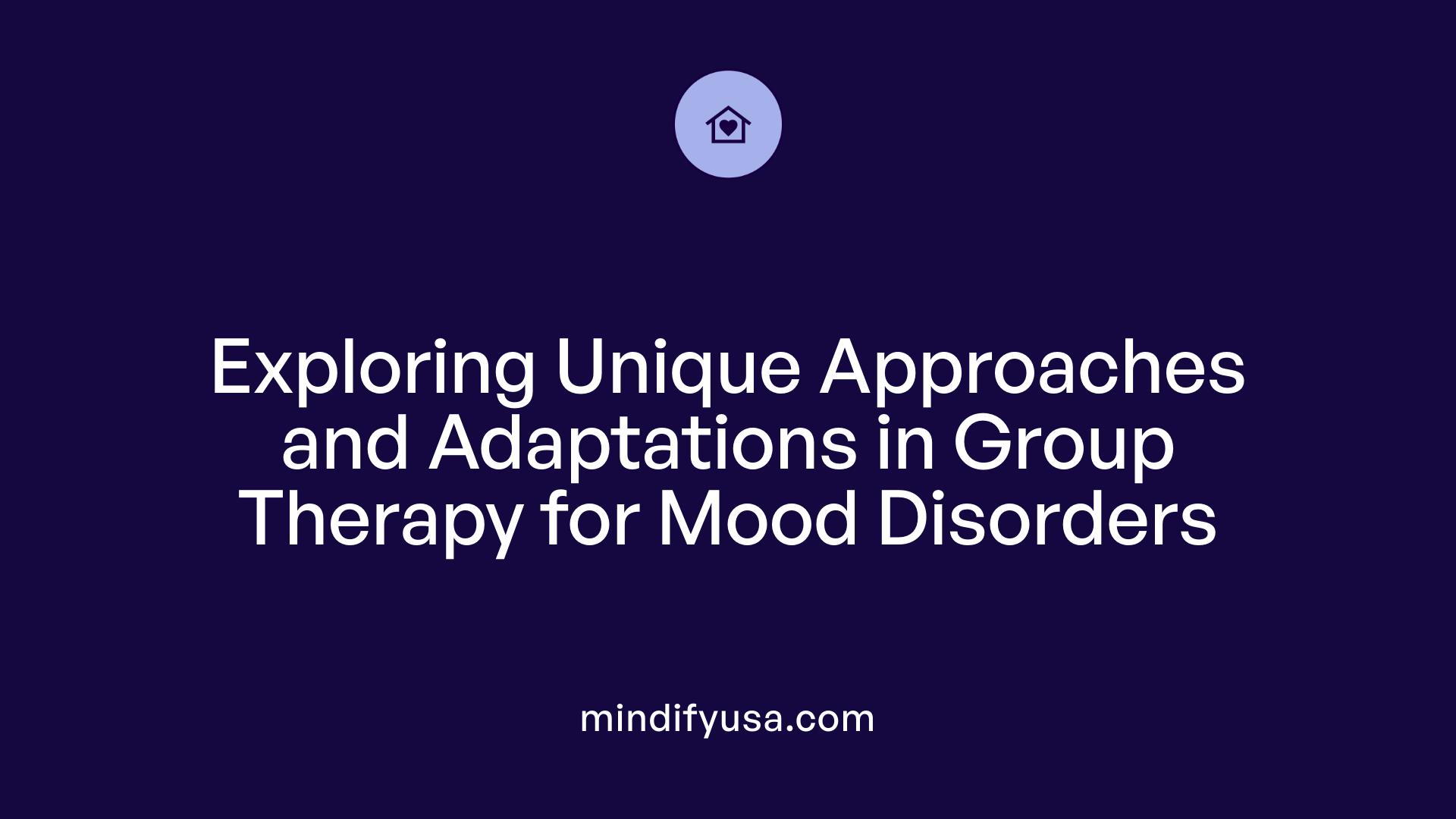
Are there specific adaptations or considerations for group therapy tailored to adults with mood disorders?
Group therapy for adults experiencing mood disorders, such as depression and bipolar disorder, requires careful adaptations to maximize effectiveness and ensure safety. One important consideration is the transition to online formats, which has become increasingly common. Facilitators utilize secure, licensed platforms like Zoom to protect confidentiality, while also using features such as reactions, polls, and screen sharing to increase participant engagement.
Therapists play a proactive role in online environments by maintaining a strong visual presence, providing technical support, and reinforcing clear guidelines for participation. This helps create a structured and safe space where members can share openly without concerns about privacy issues.
Core therapeutic elements such as fostering group cohesion, promoting the universality of experiences, and encouraging social support continue to be vital. However, adaptations also include the integration of positive psychology principles—focusing on hope, gratitude, and resilience—to support participants' recovery and well-being.
Tailoring sessions involves considering individual symptom severity, co-occurring conditions, and personal motivation. For example, therapists may incorporate mindfulness exercises or cognitive-behavioral tools specifically aimed at mood stabilization and emotional regulation.
Overall, these adjustments make group therapy more accessible and relevant. They ensure that even in altered formats, the therapeutic process remains impactful, fostering a sense of community and hope among adults with mood disorders.
Conclusion and Future Directions in Group Therapy for Mood Disorders
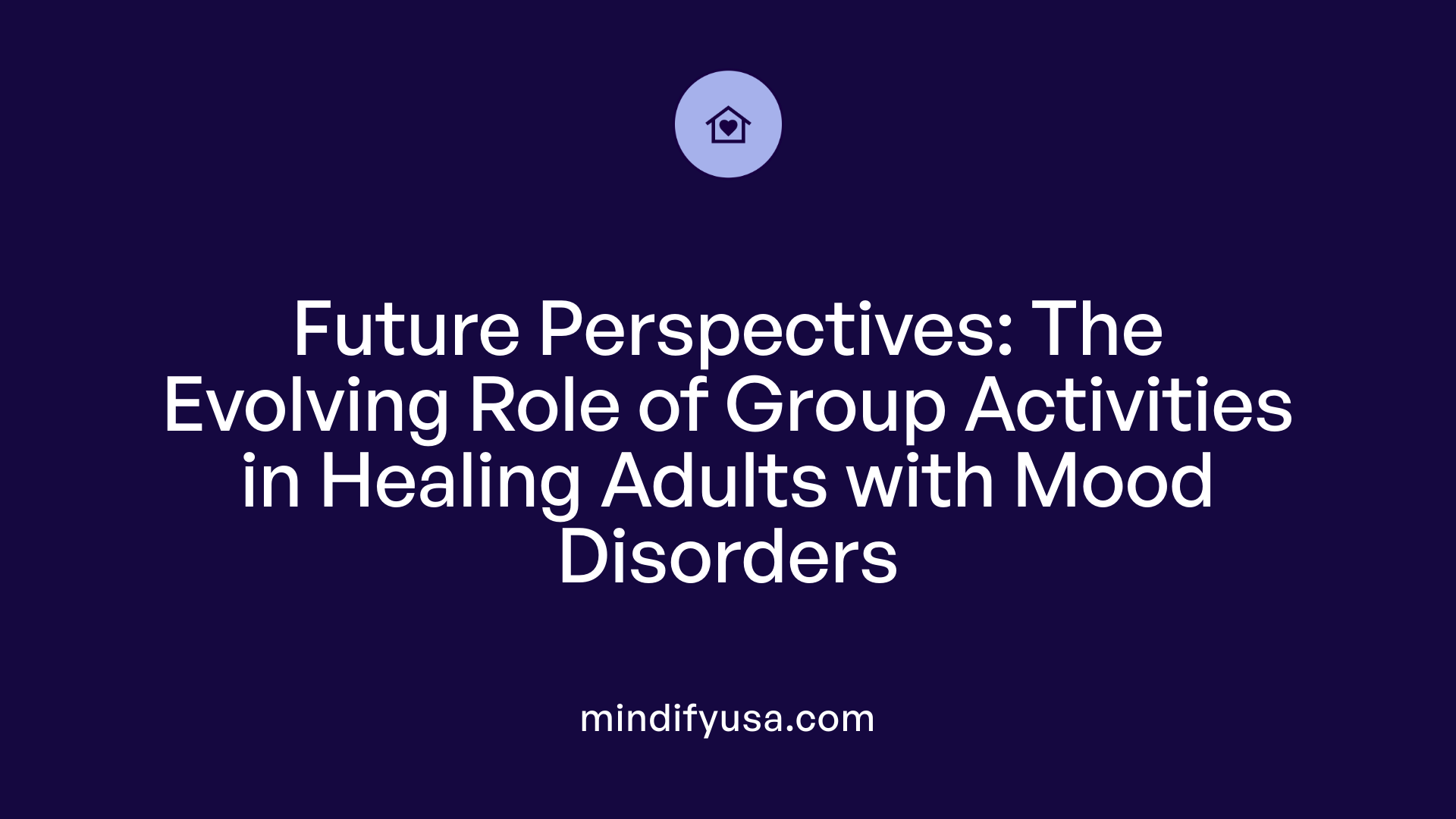
Why are group therapy activities effective in supporting adults with mood disorders?
Group therapy activities are designed to foster a safe and supportive environment where individuals can openly share their experiences and work towards emotional recovery. These shared experiences can help reduce feelings of loneliness, normalize struggles, and build a sense of community.
Techniques like role-playing, art therapy, and guided discussions encourage self-expression and empathy among members. For example, role-playing can help individuals practice new coping skills, while creative activities like storytelling or art provide outlets for emotional processing.
By engaging in these activities, participants often experience increased self-awareness and emotional wellbeing. This not only supports personal growth but also nurtures shared understanding among group members, which is crucial in managing mood disorders.
What types of activities are common in group therapy for mood conditions?
Common activities include sharing personal life stories, mapping out problems, expressive arts storytelling, and practicing affirmations or goal setting. Activities like thought replacement exercises, which are based on cognitive-behavioral therapy (CBT), help reframe negative thinking patterns.
In narrative therapy approaches, clients identify chapter titles of their life stories or create statement of position maps, reinforcing ownership of their personal narratives. These activities empower individuals to see themselves as active agents in their healing process.
For anxiety and depression, activities such as positive affirmations, brainstorming healthy goals, and cognitive restructuring exercises facilitate symptom management. Additionally, interventions targeting loneliness involve pairing members for interviews or increasing social interactions to boost social connectivity.
Dealing with grief involves discussing triggers and sharing positive memories to process loss healthily. Mindfulness exercises, including mindful eating, breathing, and yoga, are also incorporated to improve mental health and emotional regulation.
How do these activities foster personal growth?
Activities focused on strength recognition, creating worth jars, and affirmations help improve self-esteem and resilience. These exercises encourage individuals to recognize their strengths and build a positive self-image.
Closing activities, such as creating group mottos or collaborative artwork, reinforce session themes and prepare members for termination, ensuring gains are consolidated.
What is the historical background of group therapy?
The concept of group therapy dates back to 1905, when Joseph Pratt observed that emotional connection and support within groups led to increased hope and better recovery, particularly in tuberculosis patients. Since then, it has developed into a versatile and evidence-based approach for various mental health issues.
What conditions can group therapy treat?
Group therapy is effective for a wide range of conditions, including trauma, anxiety, depression, PTSD, ADHD, OCD, personality disorders, eating disorders, and chronic pain. It can also support recovery from substance use disorders by helping individuals identify triggers, share coping strategies, and maintain accountability.
What theories underpin group therapy practices?
Different theoretical approaches inform group therapy, including interpersonal, psychodynamic, social systems, cognitive-behavioral, psychodrama, redecision, and existential models. These frameworks guide activity selection and interaction styles to optimize outcomes.
How does group therapy improve emotional health?
Engagement in structured sessions with empathetic facilitators enhances the development of social skills, fosters hope, and promotes emotional regulation. The therapeutic factors—such as universality, cohesion, and interpersonal learning—are vital for emotional growth.
What evidence supports the efficacy of group therapy?
Research indicates that group therapy is as effective as individual therapy for many conditions. Outcomes such as reductions in depressive symptoms, improved quality of life, and prevention of relapse—especially in bipolar disorder—underscore its value.
How has technology influenced group therapy?
During the COVID-19 pandemic, many programs transitioned to online formats using secure platforms like Zoom. Innovations included technological upskilling, revised confidentiality agreements, and strategies to maintain group cohesion virtually. Preliminary feedback suggests high satisfaction, demonstrating online group therapy's feasibility and acceptability.
What are the roles of therapists and group dynamics?
Therapists serve as facilitators, observers, and educators, guiding discussions while ensuring emotional safety. They monitor group interactions to promote cohesion and manage conflicts. Effective group dynamics—marked by shared goals, mutual support, and trust—are essential for successful treatment.
| Aspect | Description | Additional Details |
|---|---|---|
| Active Techniques | Role-playing, art therapy, mindfulness, storytelling | Enhance self-expression and emotional regulation |
| Theoretical Approaches | Cognitive-behavioral, psychodynamic, interpersonal, systems | Guide activities and group interactions |
| Treatment Conditions | Depression, anxiety, PTSD, bipolar disorder, OCD, etc. | Evidence supports broad applications |
| Therapist Roles | Facilitator, observer, educator | Foster safety, cohesion, and growth |
| Outcomes | Symptom reduction, improved wellbeing | Supported by research and clinical studies |
Through diverse activities, skilled facilitation, and an understanding of group dynamics, group therapy continues to evolve as a vital approach for supporting adults with mood disorders.
Summary and Looking Ahead
Group therapy continues to evolve as a vital modality for treating adult mood disorders, combining evidence-based practices with innovative adaptations like telepsychology. Understanding group dynamics, therapist roles, and tailored activities enhances its effectiveness. Future research and technological integration hold promise for making group therapy more accessible, engaging, and personalized, ensuring that individuals battling mood disorders receive sustained support and opportunity for growth.
References
- 29 Best Group Therapy Activities for Supporting Adults
- Group Therapy - StatPearls
- 10 Group Therapy Topics to Improve Mental Health and ...
- Adapting a mood disorders group therapy programme for ...
- Understanding Group Therapy Dynamics
- 29 Best Group Therapy Activities for Supporting Adults
- Adapting a mood disorders group therapy programme for ...












